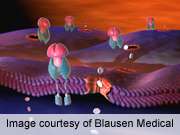Select sodium channel blockers have anti-diabetic effects

(HealthDay)—Blockade of voltage-gated sodium channels (NaChs) in pancreatic α cells has anti-diabetic effects, according to research published online May 8 in Diabetes.
Arvinder K. Dhalla, Ph.D., of Gilead Sciences in Fremont, Calif., and colleagues tested the hypothesis that the mechanism by which ranolazine, a NaCh blocker approved for use in angina, exerts anti-diabetic effects is inhibition of glucagon release through blockade of sodium channels in pancreatic α cells.
The researchers found that ranolazine causes blockade of sodium channels in pancreatic α cells, inhibits their electrical activity, and reduces the release of glucagon. The release of glucagon in human pancreatic islets is mediated by the Nav1.3 isoform. In animal models, ranolazine and a more selective sodium channel blocker, GS-458967, reduced postprandial and basal glucagon levels; these changes were associated with a reduction in hyperglycemia.
"The findings from the present study suggest that inhibition of α-cell INa could become an attractive drug target for combination with other classes of anti-diabetic agents," the authors write.
More information:
Abstract
Full Text (subscription or payment may be required)
Copyright © 2014 HealthDay. All rights reserved.
















